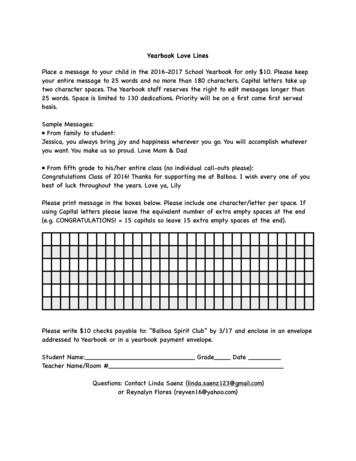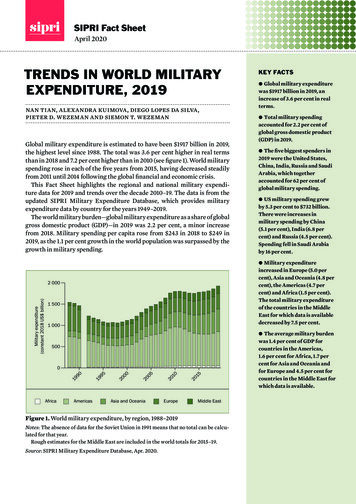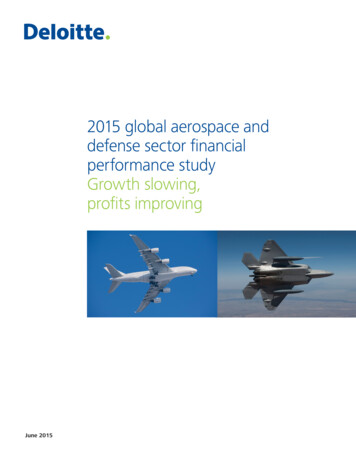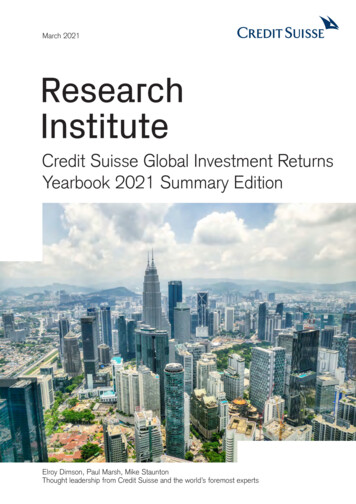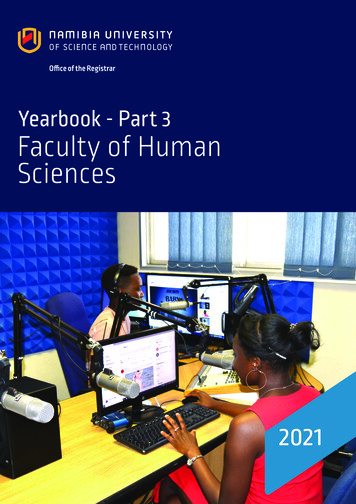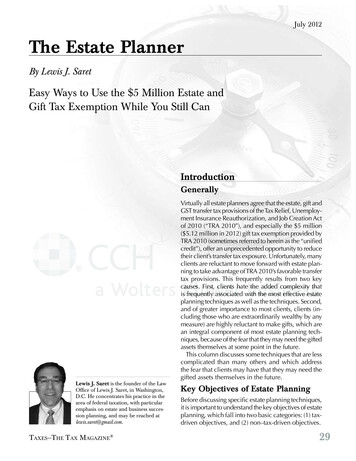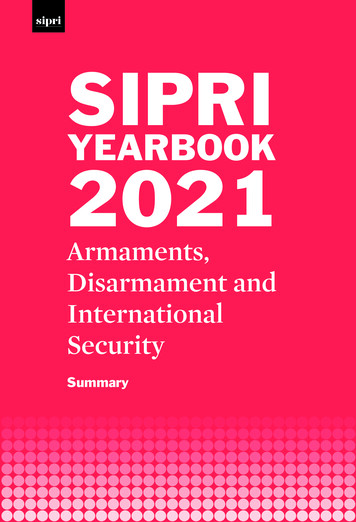
Transcription
SIPRIYEARBOOK2021Armaments,Disarmament andInternationalSecuritySummary
STOCKHOLM INTERNATIONALPEACE RESEARCH INSTITUTESIPRI is an independent international institute dedicated to research into conflict,armaments, arms control and disarmament. Established in 1966, SIPRI provides data,analysis and recommendations, based on open sources, to policymakers, researchers,media and the interested public.THE SIPRI YEARBOOKSIPRI Yearbook 2021 presents a combination of original data in areas such as world militaryexpenditure, international arms transfers, arms production, nuclear forces, armed conflictsand multilateral peace operations with state-of-the-art analysis of important aspects of armscontrol, peace and international security.This booklet summarizes the contents of SIPRI Yearbook 2021 and provides samples of thedata and analysis that it contains.CONTENTS1. Introduction: International stability and human security in 20201Part I. Armed conflict and conflict management, 20202. Global developments in armed conflict, peace processes and peace operations3. Armed conflict and peace processes in the Americas4. Armed conflict and peace processes in Asia and Oceania5. Armed conflict and peace processes in Europe6. Armed conflict and peace processes in the Middle East and North Africa7. Armed conflict and peace processes in sub-Saharan Africa2456810Part II. Military spending and armaments, 20208. Military expenditure9. International arms transfers and developments in arms production10. World nuclear forces121416Part III. Non-proliferation, arms control and disarmament, 202011. Nuclear disarmament, arms control and non-proliferation12. Chemical and biological security threats13. Conventional arms control and regulation of new weapon technologies14. Dual-use and arms trade controls18202224Annexes26Maps, pp. 6, 9, 10. Credit: Hugo Ahlenius, Norpil.www.sipriyearbook.org SIPRI 2021
1. INTRODUCTION:INTERNATIONAL STABILITYAND HUMAN SECURITY IN 2020dan smithFollowing a sharp deterioration in globalstability and security during the lastdecade, the balance sheet largely remainedunchanged in 2020. In a year dominatedby the Covid-19 pandemic, that conclusionmight seem overly optimistic. However,it is supported by the evidence in the52nd edition of the SIPRI Yearbook.The broad trends indicate a mixedpicture: global military spending continuedto rise, but the volume of international armstransfers remained roughly stable; nucleararms control continued to stagnate andthe United States withdrew from the1992 Treaty on Open Skies, but the Treatyon the Prohibition of Nuclear Weaponsreceived sufficient support to enter intoforce in January 2021; the number of armedconflicts increased again, but the globaltotal of fatalities in war fell significantly;and, although geopolitics remained toxic, abalance was largely maintained betweenpotential escalation and restraint in mostgeopolitical hotspots. Climate changecontinued apace—2020 was the equalwarmest year for which temperatures havebeen recorded going as far back as 1850—but some progress was made at the ClimateAmbition Summit held in December 2020,albeit that the targets and pledgesannounced appear insufficient to meet theaim of restricting global warming to 2 C.The Covid-19 pandemicBy the end of 2020, some 82 million peoplewere recorded as having contractedCovid-19 and recorded deaths numberedapproxi mately 1.8 million—although bothfigures are probably major underestimates.While the pandemic had little direct impacton the conduct of armed conflicts in 2020, itled to increases in psychological stress anddomestic violence. The pandemic also hadmajor economic and political effects. It ledto reduced economic output in all except20 countries, reversed three decades ofprogress in poverty reduction, and contri buted to widespread deterioration in thequality of democracy. All these effects willin turn have possible future securityconsequences.The US electionThe 2020 US presidential election resultbrought to an end a US administration thathad challenged multiple features of theinternational system. However, there islittle reason to think that global politicswill swiftly become less con f rontational asUS competition with China and Russia willprobably continue. Mean while, thereremains considerable support within theUSA for the politics and policies of theprevious administration. This will cast along shadow over international relationsas other governments ponder how muchthey can rely on US undertakings andcommitments.International cooperationThe political disputes that festeredthroughout 2020 about responsibility forthe origin of Covid-19 were symptoms of anailing international body politic. Despitethis, many institutions of internationalcooperation remained vibrant, but simplyrequired greater care and attention.Perhaps what is most important at the startof 2021 is to strengthen and re-energizeroutines of international cooperation. introduction 1
2. GLOBAL DEVELOPMENTSIN ARMED CONFLICT,PEACE PROCESSES ANDPEACE OPERATIONSActive armed conflicts occurred in at least39 states in 2020 (5 more than in 2019): 2 inthe Americas, 7 in Asia and Oceania, 3 inEurope, 7 in the Middle East and NorthAfrica (MENA) and 20 in sub-SaharanAfrica. As in preceding years, most tookplace within a single country (intrastate),between government forces and one ormore armed non-state group(s). Two intrastate conflicts were major armed conflicts(with more than 10 000 conflict-relateddeaths in the year)—Afghanistan andYemen—and 16 were high-intensity armedconflicts (with 1000–9999 conflict-relateddeaths)—Mexico, Syria, Nigeria, the Democratic Republic of the Congo, Ethiopia,Somalia, Mali, Iraq, South Sudan, BurkinaFaso, Mozambique, Cameroon, Libya, thePhilippines, India and Niger. Only twoarmed conflicts were fought betweenstates: the ongoing border clashes betweenIndia and Pakistan, and the border conflictbetween Armenia and Azerbaijan forcontrol of Nagorno-Karabakh, which escalated into a high-intensity conflict. Twoother armed conflicts were fought betweenstate forces and armed groups that aspiredto statehood (between Israel and thePalestinians and between Turkey and theKurds).Consequences of armed conflictFor at least the second consecutive year thetotal estimated number of conflict-relatedfatalities decreased. The total in 2020 wasapproximately 120 000—a 30 per centreduction since 2018. The decrease in 2020was largely driven by reductions in conflictrelated fatalities in Asia and Oceania, andMENA. Two regions bucked this trend:Europe, because of the armed conflictbetween Armenia and Azerbaijan; and subSaharan Africa (see Conflict-related Fatality Estimates in sub-Saharan Africa). Whileconflict-related fatalities have declined inrecent years, other negative impacts ofarmed conflict (sometimes in combinationa r m e d c on f l ic t s i n 2 0 2 0Major armed conflicts with10 000 or more conflictrelated deaths in 2020.High-intensity armed conflictswith 1 000 to 9 999 conflictrelated deaths in 2020.Low-intensity armed conflictswith 25 to 999 conflictrelated deaths in 2020.Note: The boundaries used in this map do not imply any endorsement or acceptance by SIPRI.2 sipri yearbook 2021 , summary
c on f l ic t - r e l at e d fata l i t ye s t i m at e s i n s u b - s a h a r a na f r ic aEighteen of the 20 armed conflicts in subSaharan Africa had a higher number ofestimated conflict-related fatalities in 2020than in 2019—and the net increase was about41 per cent. It was the region with the mostconflict-related fatalities in 2020, overtakingthe Middle East and North Africa.with other factors) appear to have increasedin severity, including population displacement, food insecurity, humanitarian needs,and violations of international humani tarian law.Peace agreements and the impactof Covid-19While many peace processes either stalledor suffered serious setbacks during 2020,important advances were made in thepeace talks in Afghanistan. In addition, theceasefires in Libya and Syria suggested thatboth of those conflicts might be movingtowards some form of resolution in the nearto medium term. A Russian-brokeredceasefire ended the fighting in Nagorno- Karabakh. However, in sub-Saharan Africa,the peace process in Sudan was the only oneto make substantive progress in 2020.The impact of Covid-19 on armed conflicts in 2020 was mixed: there were sometemporary declines in armed violence, butthe intensity of violence generally stayed atthe same level and in some cases increased.Trends in multilateral peace operationsThere were 62 active multilateral peaceoperations in 2020; one more than theprevious year. Three operations ended in2020: the Economic Community of WestAfrican States Mission in Guinea-Bissau(ECOMIB); the African Union (AU)–UnitedNations Hybrid Operation in Darfur(UNAMID); and the UN IntegratedPeacebuilding Office in Guinea-Bissau(UNIOGBIS). Three oper ations started in2020: the AU Military Observers Missionto the Central African Republic (CAR)(MOUACA), the European Union (EU)Common Security and Defence PolicyAdvisory Mission in CAR (EUAM RCA)and the AU Mission in Libya.The number of personnel deployed inmultilateral peace operations decreased by7.7 per cent during 2020, to reach 127 124 on31 December 2020. This was mainly drivenby reductions in some large multilateralpeace operations, especially the ResoluteSupport Mission (RSM) in Afghanistan.The UN remains the leading organizationin the field, with responsibility for aboutone-third of all multilateral peace oper ations and two-thirds of all personnel.In 2020 the AU Mission in Somalia(AMISOM) continued to be the largestmulti lateral peace operation, despitefurther force reductions. Ethiopia remainedthe top troop contributor, followed byUganda and Bangladesh.In 2020 the annual fatality rate for hostiledeaths of uniformed personnel in UN peaceoperations was the lowest in the decade2011–20. However, the fatality rate fordeaths from all causes was higher than inprevious years because of a significantincrease in the number of deaths due toillness, including Covid-19.The number of operations that are not‘multilateral peace operations’ (as definedby SIPRI) continued to increase, with threenew deployments in 2020: a Russian ‘peace keeping contingent’ in Nagorno-Karabakh;the EU Naval Force Mediter ranean Oper ation Irini; and the European multinationalTask Force Takuba in the Sahel. armed conflict and conflict management 3
3. ARMED CONFLICT AND PEACEPROCESSES IN THE AMERICASThe Americas presented a complex andmixed picture for peace during 2020, withworsening conflict in certain countries, butless violence in some, partly as a result ofCovid-19 pandemic-related lockdowns.In others, armed violence continuedat a similar level to that in 2019. Twocountries—Colombia and Mexico—hadseveral parallel non-international armedconflicts on their territories.The region hosted three multilateralpeace operations: the United Nations Verifi cation Mission in Colombia, the Organi zation of American States Mission toSupport the Peace Process in Colombia,and the UN Integrated Office in Haiti.ColombiaThe 2016 peace accord between theGovern ment of Colombia and the Revo lution a ry Armed Forces of Colombia–People’s Army (Fuerzas Armadas Revo- lucionarias de Colombia–Ejército delPueblo, FARC–EP) brought an end to a noninternational armed conflict that hadendured for over 50 years. However, imple mentation of the peace agreement con tinued to encounter problems in 2020.Non-international armed conflicts withother armed non-state groups and para military organizations, including theNational Liberation Army (Ejército deLiberación Nacional), the Popular Liber ation Army (Ejército Popular de Liber ación) and the Gaitanista Self-DefenseForces of Colombia (AutodefensasGaitanistas de Colombia), continued. SomeFARC–EP dissidents joined armed groups,and violence against civil society actorsincreased.4 sipri yearbook 2021 , summaryMexicoIn Mexico there were three noninternational armed conflicts: betweenthe Government of Mexico and the JaliscoNew Generation Cartel (Cártel JaliscoNueva Generación), between the govern ment and the Sinaloa Cartel, and betweenthe two cartels themselves. Homicidesdeclined slightly in 2020 but remained at avery high level, while government efforts tocounter the cartels became increasinglymilitarized. A new National Guard createdin 2019 had around 100 000 personnel bythe end of 2020, controlled by a militaryoperational command.Criminal violence and political unrestHomicide rates across the region variedsignificantly. In 2020 several countries inthe Americas, such as Jamaica, remainedamong those with the highest homiciderates in the world, while others, includingEl Salvador, Guatemala, Honduras andVenezuela, saw a significant reduction inhomicides.There was targeted political violencetowards human rights activists and socialmovement representatives in somecountries in 2020, including Brazil,Colombia, Honduras and Mexico. As aresult of Covid-19-related lockdowns, 2020did not bring a repeat of the often-violentmass demonstrations and riots thatoccurred throughout 2019 in Bolivia, Chile,Colombia and Ecuador, which had beendriven by public frustrations with pooreconomic conditions, growing inequalitiesand political corruption. Nevertheless,popular protests broke out sporadically inresponse to political crises in Bolivia, Chile,Colombia, Guatemala, Nicaragua and Peru.There were allegations of harsh publicorder policing responses in several cases.
4. ARMED CONFLICT ANDPEACE PROCESSES INASIA AND OCEANIAa r m e d c on f l ic t i n k a s h m i rSeven countries in Asia and Oceaniaexperienced active armed conflicts in 2020—the same number as in 2019. There werethree in South Asia: Afghanistan (majorinternationalized civil war), India(high-intensity, interstate border andsubnational armed conflicts) and Pakistan(low-intensity, interstate border andsubnational armed conflicts). The otherfour in South East Asia—Indonesia,Myanmar, the Philippines and Thailand—were all low-intensity, subnational armedconflicts. Total conflict-related fatalities inAsia and Oceania fell by nearly 50 per centin 2020 compared with 2019.Three emerging trends in the regionremained cause for concern in 2020: (a) thegrowing Chinese–United States rivalrycombined with an increasingly assertiveChinese foreign policy; (b) the growingviolence related to identity politics, basedon ethnic or religious polarization (or both);and (c) the increase in transnational violentjihadist groups. Some of the most organizedof these groups were active in South EastAsia, most notably in Indonesia, Malaysiaand the Philippines.There were five multilateral peace oper ations active in Asia and Oceania in 2020—the same number as in 2019.AfghanistanThe war in Afghanistan remained thedeadliest armed conflict in the world,with nearly 21 000 fatalities in 2020—a50 per cent reduction on 2019. Therewere grounds for optimism following aconditional peace agreement between theTaliban and the USA in February 2020 andIn the territorial conflict between India andPakistan over Kashmir the situation in 2020largely reverted to the status quo of relativelylow levels of armed violence. This consistedof regular exchanges of artillery fire andother clashes between Indian and Pakistaniforces along the line of control, and militantattacks and Indian counter-insurgency operations inside Jammu and Kashmir. However,in June 2020, for the first time in over fivedecades, the border tensions between Chinaand India in the disputed eastern Ladakhregion of Kashmir turned deadly. A violentconfrontation, which apparently did notinvolve the use of guns, resulted in the deathsof at least 20 Indian soldiers and an unknownnumber of Chinese soldiers.the start of intra-Afghan peace talks inSeptember 2020. By the end of the year,however, the talks had faltered, violencewas continuing, and the future of the peaceprocess remained uncertain.MyanmarIn Myanmar an ongoing peace processmade little headway during the yearagainst a backdrop of continuing violence,especially in Rakhine state. However,Japan brokered a diplomatic breakthrough between the Arakan Army andthe Myanmar military in November 2020that included a de facto ceasefire. Theagreement created a vital space for dialogueand allowed the return of several thousanddisplaced people. Nonetheless, at the end of2020, the prospects for the wider peaceprocess and the voluntary return of almosta million Rohingya people forciblydisplaced in 2017 remained uncertain,despite worsening humanitarian conditionsin the refugee camps in Bangladesh. armed conflict and conflict management 5
During the year, three further levelsof complexity added to these existingtensions: (a) the outbreak of the Covid-19pandemic; (b) political protests in Belarusfollowing a disputed presidential electionin August 2020; and (c) increased tensionsin the eastern Mediterranean that werecentred on Greece and Turkey but alsoinvolved several other countries. On a morepromising note, a modest Kosovo–Serbiadétente was mediated by the United Statesin September 2020.There were 18 multilateral peace oper ations active in Europe in 2020—the samenumber as in the previous year.5. ARMED CONFLICT ANDPEACE PROCESSES IN EUROPETwo armed conflicts were active in Europein 2020: the interstate border conflictbetween Armenia and Azerbaijan forcontrol of Nagorno-Karabakh, whichescalated into a high-intensity conflictduring the year, and the ongoing lowintensity inter nationalized, subnationalarmed conflict in Ukraine. Elsewhere inEurope, tensions persisted in largelyinactive but unresolved conflicts in thepost-Soviet space, the Western Balkans andCyprus. There were also persistent tensionsbetween Russia and large parts of the restof Europe, over issues as diverse ascyberattacks, Ukraine, the response toCovid-19, and the poisoning of Russianopposition leader Alexei Navalny. Inaddition, irregular migration andterrorism—linked to serious and complexsecurity challenges in Europe’s southernneighbourhood and beyond—remainedimportant security concerns in 2020.Armed conflict between Armeniaand AzerbaijanThe six weeks of armed conflict that brokeout in 2020 between Armenia andAzerbaijan was the most intense period offighting since the 1988–94 NagornoKarabakh War. Azerbaijan is widelybelieved to have planned and initiated theoffensive, having built up its militaryRUSSIAGEORGIAt h e di s p u t e d t e r r i t ory of n ag or no - k a r a b a k h , j u ly 2 0 2 andik ian-occupied territoryLine of contactNote: The boundaries used in this map do not imply any endorsement or acceptance by SIPRI.6 sipri yearbook 2021 , summary80 km
c e a s e f i r e v iol at ion s i n u k r a i n e , 1 3 ja n . t o 1 3 de c . 2 0 2 015 000No. of ceasefire violations12 0009 0006 0003 00026Ja9 n.Fe23 b.F8 eb.M22 ar.M5 ar.Ap19 r.A3 pr.M17 ayM31 ayM14 ayJ28 uneJu12 neJ26 ulyJ9 ulyAu23 g .A6 ug.Se20 p.Se4 p.Oc18 t.O1 ct.N15 ov.N29 ov.N13 ov.Dec.0capacity over some years. Azerbaijanreceived military and political supportfrom Turkey and had access to armedunmanned aerial vehicles purchased fromIsrael and Turkey. These factors appearedto be central to Azerbaijan’s militarysuccess in regaining control of about onethird of Nagorno-Karabakh and most of theadjacent territories by the time the fightingsubsided. Military and civilian fatalitiescaused by the fighting were estimated tototal around 6700.A Russian-brokered ceasefire inNovember 2020 halted the fighting, and atthe end of the year Russian peacekeeperswere helping the two sides to maintain anuneasy truce. However, several key issueshave still to be clarified, including thefuture status and governance of NagornoKarabakh, how to reconcile potentiallycompeting claims of returning internallydisplaced persons, Turkey’s role in theimplementation of the agreement, andthe future of the Minsk Process of theOrganization for Security and Co-operationin Europe. A new stalemate—but ondifferent terms to the previous 30-yearstalemate—now seems likely.UkraineUkraine has been the focus of Europe’smain territorial conflict since 2014. In 2020it was again not possible to bridge thefundamental disagreements among theparties about the nature of the conflict andtheir involvement in it, and the implemen tation of existing agreements. A newceasefire agreement in July 2020 led tomuch lower levels of ceasefire violations inthe latter part of the year. However, giventhat there have been more than 20 previousceasefire attempts in the six years ofconflict, it is difficult to predict whether orhow long the ceasefire will remain in effect.There were an estimated 109 conflictrelated deaths in 2020 (down from 403 in2019 and 893 in 2018). Based on thesituation in Ukraine at the end of 2020, theindications are that the conflict willprobably become another of Europe’spersistent unresolved conflicts. armed conflict and conflict management 7
6. ARMED CONFLICT AND PEACEPROCESSES IN THE MIDDLE EASTAND NORTH AFRICAThere were seven states with activearmed conflicts in the Middle East andNorth Africa (MENA) in 2020 (the samenumber as in 2017–19): Egypt (lowintensity, subnational armed conflict), Iraq(internationalized civil war), Israel (lowintensity, extrastate armed conflict),Libya (internationalized civil war), Syria(internationalized civil war), Turkey (lowintensity, extrastate and subnational armedconflict) and Yemen (major international ized civil war). All the armed conflicts hadfewer fatalities than in 2019, and totalconflict-related fatalities in the region havereduced by almost 70 per cent since 2017.With conflict-related fatalities in Syriadropping below 10 000 in 2020, the war inYemen remained the region’s only majorarmed conflict. Many of these conflictswere interconnected and involved regionaland international powers, as well asnumerous non-state actors.A ceasefire in Idlib province in Syria inMarch 2020 and a nationwide ceasefireagreed in Libya in October 2020 suggestedboth of those conflicts might be open tosome form of resolution soon. However, inYemen implementation of the 2018 Stock holm Agreement remained stalled.The Covid-19 pandemic appears to havehad minimal impact on the region’s armedconflicts, although it clearly added anotherlayer of complexity to the existing humani tarian challenges. Anti-governmentprotests occurred throughout the region,with mass protests in Algeria, Iraq andLebanon, and sporadic protests in Egypt,Iran, Israel, Jordan, Morocco, thePalestinian territories and Tunisia. Inaddition, tensions between Iran and the8 sipri yearbook 2021 , summaryt h e i s r a e l i- pa l e s t i n i a nc on f l ic tCasualties in the Israeli–Palestinian conflictin 2020 were at the lowest level in the pastdecade. A new US ‘peace plan’, the threatenedannexation of parts of the West Bank and aseries of normalization agreements betweenIsrael and four states (Bahrain, Morocco,Sudan and the United Arab Emirates) werekey developments in the year. The economicand humanitarian costs to the Palestinianpeople of the Israeli occupation continued tobe severe, and there still appeared to be littleprospect of resolving the underlying Israeli–Palestinian territorial dispute.United States again threatened to escalateinto a more serious interstate militaryconflict.There were 14 multilateral peace oper ations in the MENA region in 2020—thesame number as in 2019.Complex and interlinked armed conflictsin Iraq, Syria and TurkeyDuring 2020 the government of PresidentBashar al-Assad continued to consolidateits hold in Syria, with armed oppositionfocused on two areas: Idlib province in thenorth-west, and regions in the north-eastpartially controlled by Kurds. The Marchceasefire in Idlib province led to a furtherreduction in large-scale hostil ities.In 2020 Iraq remained a fragile, largelypost-conflict state with weak institutionsand growing protests. Iran remained aninfluential presence in Iraq (as well asSyria), and Iranian–US tensions spilledover into Iraq. Turkey intensified itsmilitary oper ations in northern Iraq, andthe pro tracted armed conflict in the southeast of Turkey also continued.The Idlib ceasefire brokered by Russiaand Turkey cemented their roles as key
a r e a s of c on t rol a n d c on f l ic t i n y e m e n , m ay 2 0 2 0SAUD IARA B IASAUD IAR ABIASaadaConflict zonesAmranHa jja hRedSeaMaribSana’aYEMENHodeidahH aj jYemeni Government forcesHouthi forcesRedSeaUAE-backed anti-Houthiforces0opposed to the governmentE RITRE ATaizUAE-backed SouthernTransitional Council forcesAdenUAE United Arab Emirates.Note: The boundaries used in this map do not imply any endorsement or acceptance by SIPRI.power brokers in Syria, while US influencecontinued to wane.North Africa and the armed conflictarmed conflict. An internationally backedceasefire in Libya in October 2020 offerednew grounds for optimism.in LibyaYemenNorth Africa is undergoing a convergenceof crises, with negative spillover onto thestability of neighbouring states in theeastern Mediterranean and sub-SaharanAfrica. The 40-year territorial dispute overthe Sahrawi Arab Democratic Republic(Western Sahara) between Morocco andthe Popular Front for the Liberation ofSaguia el Hamra and Río de Oro (PolisarioFront) erupted again towards the end ofthe year, while Egypt’s low-level Sinaiinsurgency continued in 2020 with no signof an end or a decisive outcome.The deepening roles of Egypt, Russia andTurkey in the civil war in Libya compli cated peace efforts and increased the risk ofa direct military confrontation betweenTurkish and Egyptian or Russian armedforces supporting opposing sides in theDespite attempts mediated by the UnitedNations to end the civil war in Yemen, thearmed conflict there continued throughoutthe year, further exacerbating one of theworld’s worst humanitarian crises. A UNpanel of experts concluded that the patternof armed conflicts in 2020 had predomin antly shifted to economic drivers, while inOctober the UN warned that the countrywas on the brink of a catastrophic food security crisis. At the end of the year, the Houthiscontinued to dominate the Yemeni political,economic and military landscape, control ling one-third of the country’s territory andtwo-thirds of the population. Agreeing alasting political settlement remains fraughtwith difficulty as the Houthis are unlikely tostop fighting until they fully control Marib,Hodeidah and Taiz. armed conflict and conflict management 9ER IT R EAHodei
state actors and the transnational activitiesof violent Islamist groups, other armedgroups and criminal networks. The conflictdynamics and ethnic and religious tensionswere often rooted in a combination of stateweakness, corruption, ineffective deliveryof basic services, competition over naturalresources, inequality and a sense ofmarginal ization. Security dilemmas in subSaharan Africa in 2020 were also shapedby election-related violence and the impactof the Covid-19 pandemic, as well as waterinsecurity and the growing impact ofclimate change.A peace process in Sudan was the onlyone in sub-Saharan Africa to make sub stantive progress in 2020. There were22 multilateral peace operations activein sub-Saharan Africa during the year—2 more than in 2019.7. ARMED CONFLICT ANDPEACE PROCESSES INSUB-SAHARAN AFRICAThere were at least 20 states (out of a total of49 states) with active armed conflicts insub-Saharan Africa in 2020: Angola,Burkina Faso, Burundi, Cameroon, theCentral African Republic (CAR), Chad, Côted’Ivoire, the Democratic Republic of theCongo (DRC), Ethiopia, Guinea, Kenya,Madagascar, Mali, Mozambique, Niger,Nigeria, Somalia, South Sudan, Sudan andUganda. Ten were low-intensity, sub national armed conflicts, and 10 were highintensity armed conflicts (Nigeria, the DRC,Ethiopia, Somalia, Mali, South Sudan,Burkina Faso, Mozambique, Cameroon andNiger). Except for CAR and Somalia, all theother 18 armed conflicts had higherestimated conflict-related fatalities in 2020than in 2019. The total regional increasewas about 41 per cent, giving the region themost conflict-related fatalities globally.Almost all the armed conflicts wereinternationalized, including as a result ofWest AfricaThe security situation in West Africadeteriorated rapidly in 2020, with armedtransnational religious groups extendingw e s t a f r ic a , c e n t r a l s a h e l a n d l aAlgeriake ch adAtlanticOceanMauritaniaMaliCentral SahelSenegalCaboVerde rCôted’IvoireLiberiaHigh-intensity armed conflictsBeninTogoGhanaLake CongoDem.Low-intensity armed conflictsRep.CongoNote: The boundaries used in this map do not imply any endorsement or acceptance by SIPRI.10 sipri yearbook 2021 , summary
their grip in the region. The ongoingproliferation of community-based militiasalso exacerbated existing conflicts. Thearmed conflicts in Burkina Faso, Mali andNiger worsened, especially within the triborder Liptako-Gourma region. The newEuropean Task Force Takuba, led byFrance, added to the existing externalnational and multilateral counterterrorismoperations in the Sahel and Lake Chadregions alongside more traditional multi national United Nations peace operations.The armed conflicts in Chad and Nigeriaalso worsened in the context of increasinginstability in the Lake Chad region.Central AfricaIn Central Africa there was a large upsurgein violence in the east of the DRC, asexternal and Congolese armed groupsengaged in multiple armed conflicts withthe govern ment. This was coupled with aresurgence of intercommunal violence.Much of this violence was driven bycompetition for resources, corruption andweak gover nance. The two unrelatedarmed conflicts in different parts ofCameroon—the anglo phone separatist
control, peace and international security. This booklet summarizes the contents of SIPRI Yearbook 2021 and provides samples of the data and analysis that it contains. CONTENTS 1. Introduction: International stability and human security in 2020 1 Part I. Armed conflict and conflict management, 2020 2.
